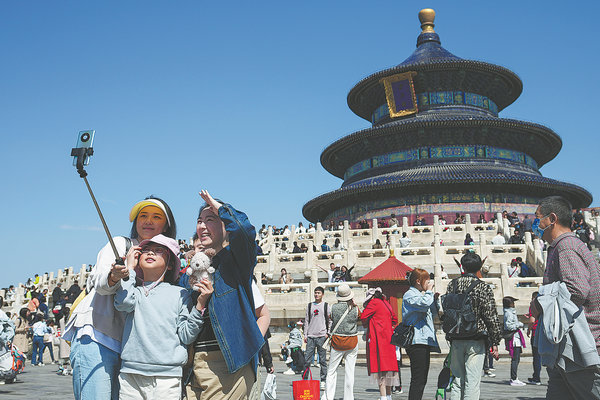
Tourists pose at the Temple of Heaven in Beijing during the May Day holiday. [Photo/Xinhua]
During this year's May Day holiday, more and more Chinese tourists are adding destinations such as museums and art galleries to their itinerary, suggesting an upward trend in China's domestic cultural tourism sector.
Among the country's traditional culture fanatics is a woman surnamed Dong. She was in charge of arranging her family's tour from Langfang, North China's Hebei province, to Beijing during the five-day holiday. The tour's highlights included the signature visit to the Palace Museum dressed in ancient costume and seeing the treasures at the National Museum of China.
On the last day of the May Day holiday, Dong took her child to a niche museum in the eastern suburbs — the exhibition hall of China Railway Museum.
They took photos on the station platforms and with all kinds of locomotives, and her child enjoyed a ride on a small steam train while learning more about the history of China's railway development. Clutching his favorite toy, a train-like Transformer robot, the young boy had a great time before, eventually, it was time to depart for their journey home.
As the first May Day holiday since the country optimized its COVID-19 pandemic response measures, cultural tourist attractions, especially museums and art galleries, have become a hot new trend.
Local residents and tourists from afar shuttled between all kinds of museums, wandering around various exhibitions, busy viewing rarities from all over the world and experiencing tangible and intangible cultural exchanges, both ancient and modern, between home and abroad.
Data collected by multiple museums show that the number of visitors during the holiday rebounded to higher than that recorded pre-COVID during the same period in 2019. On the first day of the May Day holiday, the top 10 scenic spots in Beijing in terms of visitor numbers included several cultural tourist attractions: Qianmen Street, the Summer Palace, Nanluogu Xiang shopping alley, the Temple of Heaven, Beihai Park and Yuanmingyuan, or the Old Summer Palace.
Cultural institutions were also a preferred choice for those seeking a relaxed and enjoyable holiday experience.
During the recent holiday, museums and art galleries all over China teamed up with foreign counterparts to make their exhibits more innovative and attractive, with an almost panoramic view of the worldwide cultural treasures on offer.
Digital technologies also helped to give visitors a more immersive experience, adding strong impetus to the arts and culture craze in China.
A retrospective exhibition named Parallel Space — Meet the Terracotta Warriors in Greece digitally presents the archaeological achievements collected and preserved in the National Archaeological Museum of Athens, the archaeological sites of Terracotta Warriors, and a relevant cultural relics protection laboratory of China.
With the help of digital technologies, visitors in Shougang Park in western Beijing can see the ancient warriors stand face-to-face with the statue of Kroisos Kouros, seemingly engaging in a "dialogue" across time and space.
As China's night economy continues to heat up, some museums extended their opening hours, and even remained open at night, during the holiday.
Among them, more than 30 museums in Beijing, such as the Capital Museum and China Railway Museum, kept their doors open after hours. Many famous buildings in the city held related nighttime activities, allowing visitors to appreciate their special beauty under the night sky.
From May 1-3, Beijing held a bazaar selling all kinds of cultural and creative products from over 40 museums in the city, highlighting a collaboration between time-honored brands and new fashion forms.
"Beijing is rich in museum resources, so I chose to visit the bazaar during the holiday with my classmates. I've collected multiple museum seals today. Each seal is a cultural imprint for me," says Ma Hualin, a graduate student at Beijing University of Chemical Technology, who visited the bazaar on May 1.
One visitor, surnamed Zheng, traveled from South China's metropolis of Guangzhou all the way to Beijing. After a one-day tour of the Civil Aviation Museum, Zheng took his family to the bazaar on May 1. Luckily, as part of an interactive on-site activity, he guessed correctly the name of an aircraft model on display, based on a vague description, winning a cartoon postcard of the plane.
"My son likes to study all kinds of planes, so I took him to the bazaar, hoping to help broaden his horizons," Zheng says.
"Now, society pays great attention to museums, and the number of people who like to visit museums is expanding. People of different ages visit museums for various reasons, such as to view exhibitions, listen to lectures, participate in social and educational activities, or simply to just buy things," says Gu Ying, deputy director with the White Pagoda Temple administrative office.
"Museums are an important force to inspire wisdom for a better life, promote social well-being and build a sustainable future. Behind the cultural tourism craze is the public's discovery and recognition of the historical and cultural value of the museums," says Bai Chong, director of the museum division of Beijing municipal bureau of cultural heritage.














